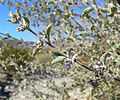Hyptis emoryi
| Hyptis emoryi | |
|---|---|
 | |
| Hyptis emoryi–terminal flower | |
| Conservation status | |
| Scientific classification | |
| Kingdom: | Plantae |
| (unranked): | Angiosperms |
| (unranked): | Eudicots |
| (unranked): | Asterids |
| Order: | Lamiales |
| Family: | Lamiaceae |
| Genus: | Hyptis |
| Species: | H. emoryi |
| Binomial name | |
| Hyptis emoryi Torr. | |
| Wikimedia Commons has media related to Hyptis emoryi. |
Hyptis emoryi (desert lavender) is a large, multi-stemmed shrub species of flowering plant in the Lamiaceae. The genus Hyptis is commonly known as the bushmints.
It is one of the favored plants of honeybees in early spring in the southwest deserts of North America.
Description
Desert lavender is a medium to tall cold tender perennial shrub found in the southwestern United States of Arizona, Nevada, California, and northwestern Mexico in Sonora and Baja California.
It is a multi-stemmed shrub reaching 15–18 ft in optimum locations. It has violet-blue flowers up to 1 in, in leaf axils. The flowers are profuse along the main stem and side branches and is an aromatic attractor of the honeybee and other species. Leaves are oval and a whitish gray-green-(in deserts), serrated margins, hairy, and 2-3 in. It is found in dry washes, and on rocky slopes, up to 3000 ft (900 m). It is evergreen or cold deciduous, depending on location.
Distribution and habitat
It occurs mostly in areas with a water source; in the southwestern USA deserts it is commonly in the dry washes, intermixed with other species.
In the "Creosote Bush scrub" Yuma Desert-(western Sonoran Desert) of southwest Arizona, it is found with the palo verde, Bebbia, Encelia farinosa, desert ironwood (Olneya tesota), Lycium andersonii (wolfberry or Anderson thornbush), Psorothamnus spinosus (a type of smoke tree), and Acacia greggii, as some common associated species of the washes, elevation dependent.
In Arizona, found from central to southwestern Arizona of the Sonoran Desert; in northwest Arizona found in regions of the Mojave Desert. In southern California and Nevada, desert lavender is found in southern regions of the Mojave Desert and the Colorado Desert of southeast California.
References
- Jepson Manual Treatment
- USDA: NRCS: Plants Profile Hyptis emoryi; Arizona county range; California; Nevada
- Images from the CalPhotos archive
- - Lady Bird Johnson–"Wildflower Center"
External links
- Photo-stems & flowers; Article - desert-tropicals.com–"Desert Tropicals"
- Photo: Rocky wash: w/Bebbia-(dried), Brittlebush-in yellow bloom, and Saguaro on plain; Article, Synopsis, and photo gallery - delange.org—"Arizona Wild Flowers"






